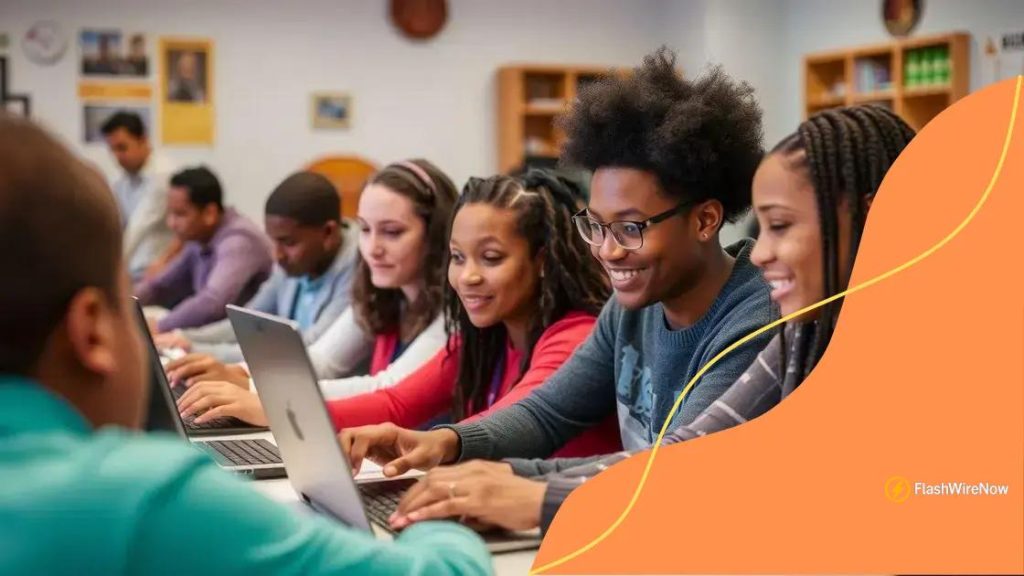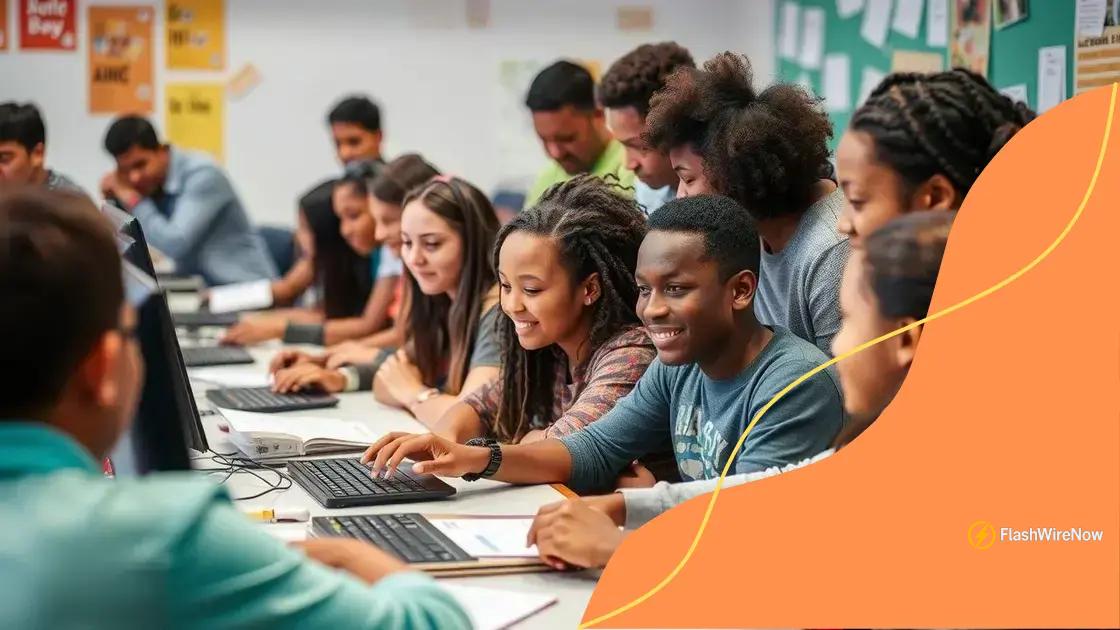Addressing the digital literacy gap: bridging the divide

Anúncios
Addressing the digital literacy gap is essential for empowering individuals and communities through targeted educational strategies and technology integration, fostering critical skills needed to thrive in today’s digital world.
Addressing the digital literacy gap is crucial in today’s tech-driven world. Are we doing enough to equip everyone with the necessary skills to thrive? Let’s dive into this important topic.
Anúncios
Understanding digital literacy
Understanding digital literacy is essential in today’s fast-paced world. It encompasses the skills needed to navigate, evaluate, and create information using digital technologies. As technology evolves, so does the definition of what it means to be digitally literate.
Defining Digital Literacy
Digital literacy refers to the ability to effectively and critically use digital tools and resources. It involves not only technical skills but also a conceptual understanding of technology’s role in society. This means knowing how to search for information online, assess its credibility, and communicate appropriately using various digital platforms.
The Importance of Digital Literacy
In an increasingly digital world, having strong digital skills is crucial for personal, academic, and professional success. With many aspects of life now operating online, those lacking adequate digital literacy face significant obstacles. They may struggle to access essential services, job opportunities, and educational resources.
Anúncios
- Increased job opportunities for digitally literate individuals.
- Better access to information and services.
- Enhanced ability to engage with the community and get involved in public life.
Moreover, digital literacy plays a vital role in fostering informed citizenship. Being able to comprehend and participate in digital discussions helps individuals advocate for their rights and influence positive changes in their communities. Digital skills not only improve individual lives but can empower entire communities.
Key Components of Digital Literacy
Several key components make up digital literacy. These include:
- Tech proficiency: The basic skills needed to use hardware and software.
- Information literacy: Evaluating the credibility and relevance of information.
- Communication: Using digital tools to share ideas effectively.
Each of these components is interconnected and contributes to an individual’s overall digital competence. As technology continues to change, it is crucial for everyone to become proficient in these areas to thrive in a digital society.
Challenges faced by different demographics
Many people face several challenges when it comes to digital literacy. Understanding these challenges is essential for creating effective solutions. Various demographics, including seniors, low-income families, and rural communities, often experience different barriers.
Digital Divide Among Seniors
Many older adults struggle with digital literacy. They often have limited experience with technology. This lack of experience can lead to feelings of frustration and anxiety when using digital devices. It’s important to provide tailored training and support for seniors, helping them to build confidence and skills.
- Access to devices: Many seniors may not own a smartphone or computer.
- Health issues: Vision or mobility problems can make using technology difficult.
- Social isolation: Seniors may feel left out as more services move online.
Additionally, younger seniors may find it easier to adapt than older generations. Thus, different training methods might be necessary.
Socioeconomic Barriers
Low-income families often face significant barriers to developing digital literacy skills. Many lack access to reliable internet connections or devices. This makes it challenging to participate in online education or job searches. Schools and organizations can help by providing resources and access to technology.
- Limited access to high-speed internet.
- Financial limitations on purchasing devices.
- Lack of supportive learning environments.
As a result, these families can fall behind in today’s digital society. Bridging this gap is vital for enhancing opportunities and fostering equality.
Challenges in Rural Communities
Rural communities often deal with unique challenges related to digital literacy. These areas may have limited internet access, which affects everything from education to healthcare. Even when devices are available, unreliable connections can hinder effective use.
Moreover, awareness of digital tools is often lower in these communities. Training programs need to be designed with local needs in mind to ensure everyone can benefit.
Strategies to improve digital literacy

Improving digital literacy is essential for empowering individuals and communities. Various strategies can be effectively implemented to enhance these skills. These strategies need to be inclusive and accessible, catering to different needs and abilities.
Community Workshops
Hosting community workshops is an excellent way to promote digital literacy. These workshops can provide hands-on training and support in a friendly environment. Participants can learn basic skills, such as using the internet, sending emails, and navigating social media.
- Workshops should be open to all age groups.
- Sessions can be tailored to specific skills.
- Collaboration with local organizations can enhance outreach.
Additionally, these workshops build a sense of community, allowing peer support to foster learning.
Online Tutorials and Resources
Offering online tutorials and resources is another effective strategy. Many people prefer learning at their own pace. Creating easy-to-follow video tutorials and guides can help individuals improve their skills in a structured manner. To make these resources accessible, it’s vital to ensure:
- Content is available in multiple languages.
- Materials are designed for various skill levels.
- Resources include interactive elements.
Providing a variety of formats can accommodate different learning styles, making learning more effective.
Partnerships with Schools and Libraries
Schools and libraries can play a crucial role in promoting digital literacy. By partnering with these institutions, organizations can implement programs to reach wider audiences. Libraries are excellent venues for training sessions, as they are often seen as trusted community resources. Programs might include:
- After-school digital literacy clubs for students.
- Parent workshops focused on internet safety.
- Resource centers for job seekers looking to improve their digital skills.
By focusing on collaborative efforts, initiatives can significantly boost digital literacy in various demographics.
The role of education in digital skills
The role of education in developing digital skills is crucial in today’s technology-driven world. As new tools and resources emerge, educational institutions must adapt their curricula to include essential digital competencies. These skills help students thrive in both academic environments and future careers.
Integrating Technology in Classrooms
Integrating technology into everyday learning helps students gain hands-on experience. Schools should provide access to computers and other devices, allowing students to explore the digital world. This access enables them to learn how to:
- Research information online efficiently.
- Utilize educational software and applications.
- Collaborate with peers via digital platforms.
Such engagement fosters a deeper understanding of how to navigate the digital landscape.
Digital Skills Training Programs
In addition to regular education, many schools and organizations offer digital skills training programs. These focus on specific skills, such as coding, online safety, and digital communication. By attending these programs, students can:
- Develop critical thinking and problem-solving skills.
- Learn to evaluate the credibility of online information.
- Gain confidence in using various digital tools.
As technology becomes increasingly important, these programs help bridge the gap between traditional education and digital literacy.
Support from Educators and Mentors
Educators play a pivotal role in guiding students through the learning process. They can provide personalized support, answer questions, and create a safe learning environment. Mentors can also help students navigate their digital journeys, offering insights and encouragement.
By fostering strong relationships between students and educators, schools can create a culture of continuous learning and curiosity about technology. This approach not only enhances digital skills but also inspires students to explore further learning opportunities and pursue careers in technology.
Future trends in digital literacy
Future trends in digital literacy are shaping the way individuals interact with technology. As society continues to evolve, several emerging trends highlight the importance of adapting to the digital landscape.
Increased Focus on Critical Thinking
As access to information grows, critical thinking will become more crucial. People need to evaluate the credibility of online content. Educational programs may start emphasizing skills that help learners discern fact from fiction. This way, students will be better prepared to:
- Analyze various sources of information.
- Identify biases and misleading claims.
- Make informed decisions based on evidence.
Encouraging a questioning mindset fosters deeper understanding and enhances media literacy as well.
Focus on Personalized Learning
Personalized learning is a trend that tailors education to each individual’s needs. With technology advancements, students can learn at their own pace. This approach allows learners to focus on areas they find challenging in a supportive environment. Educational technology can assist in creating:
- Customized learning plans.
- Adaptive learning platforms.
- Real-time feedback on progress.
This trend not only enhances digital literacy but also promotes engagement and motivation among students.
Integration of Artificial Intelligence
Artificial intelligence (AI) is changing how we approach learning and digital literacy. It can help create interactive educational experiences, making learning more appealing. Future classrooms may see greater use of AI tools that enable:
- Intelligent tutoring systems for personalized guidance.
- Chatbots for immediate assistance.
- Predictive analytics to identify learning needs.
As AI technology continues to advance, it could revolutionize how students acquire digital skills and knowledge.
Emphasis on Lifelong Learning
Lastly, lifelong learning is becoming vital. With rapid technological changes, individuals must continually update their skills. Future trends will likely promote resources focusing on ongoing education, such as:
- Online courses and webinars.
- Community training programs.
- Networking opportunities for skill sharing.
This commitment to lifelong learning ensures that everyone can keep pace in an ever-evolving digital world, ultimately helping to close the digital literacy gap.
FAQ – Frequently Asked Questions about Digital Literacy
Why is digital literacy important for everyone?
Digital literacy is essential for personal and professional success in a technology-driven world, helping individuals navigate information and communication effectively.
What are some strategies to improve digital literacy in communities?
Strategies include hosting community workshops, providing online tutorials, and forming partnerships with schools and libraries to enhance access to digital skills training.
How can schools integrate technology to promote digital literacy?
Schools can integrate technology through classroom activities, personalized learning experiences, and offering digital skills training programs to help students become proficient.
What future trends can we expect in digital literacy education?
Future trends may include a greater emphasis on critical thinking, personalized learning, the integration of artificial intelligence, and a commitment to lifelong learning.





